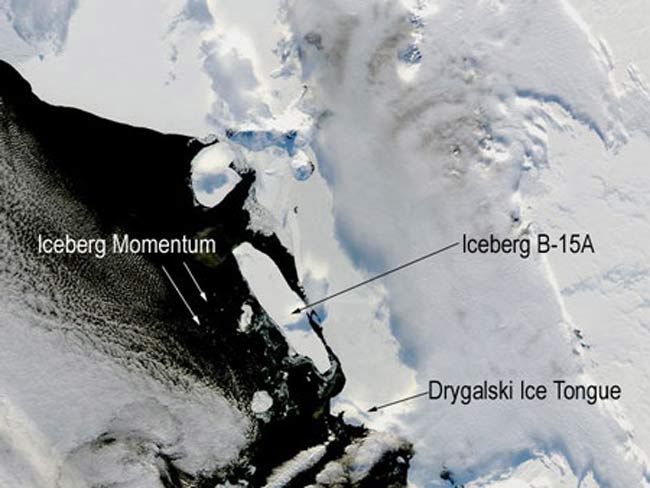Waves from Top of the World Destroy Huge Iceberg at Bottom

On a calm, clear day in October 2005, a huge Antarctic iceberg broke into half a dozen pieces. Today, scientists said the event was triggered by ocean swells kicked up during an Alaskan storm—half a world away.
At 60 miles long and 18.5 miles wide, the iceberg called B15A was half of a larger iceberg called B15, which was for a time the world's largest iceberg after breaking away from the Antarctic's in Ross Ice Shelf in 2000. Over the years, scientists put seismic monitors on B15A to better understand strange sounds called "iceberg songs."
"We deployed these instruments to look at a kind of harmonic tremor that the icebergs are making in a way that we still don't understand terribly well," said Emile Okal at Northwestern University. "We are trying to figure out how the icebergs are sort of making music when various phenomena that we think are linked to the cracking of iceberg masses takes place."
After the B15A broke into pieces, Okal's team retrieved the seismometers. Their recorded data showd that movement on the iceberg started 12 hours before the breakup and continued for three days after. Local conditions were otherwise mild, the researchers say, but the vast chunk of ice moved up and down a half-inch and four inches side to side.
By comparing arrival times of waves, the researches calculated it had been generated 8,300 miles away.
"Our jaws dropped," said Douglas MacAyeal of the University of Chicago. "We looked in the Pacific Ocean and there, 13,500 kilometers away, six days earlier, was the winter season's first really big, nasty storm that developed and lasted for about a day and a half in the Gulf of Alaska."
Further investigation confirmed the link.
Sign up for the Live Science daily newsletter now
Get the world’s most fascinating discoveries delivered straight to your inbox.
"We looked at the wave-buoy records in Hawaii and Alaska," MacAyeal explained. "We saw that the waves in Alaska were about 35 feet tall and then two days later they were down to 15 feet as they passed Hawaii on their way south." Several days later, "we see the waves arriving in Antarctica at the site where the iceberg broke up and at several other sites in Antarctica."
The finding is detailed in the October issue of the journal Geophysical Research Letters. The researchers say long-distance waves might routinely jostle icebergs in a similar manner.
- Images: Monster Waves
- Ice Shelf Collapse Reveals New Undersea World
- Shifting Icebergs May Have Forced Penguin Evolution
- New City-sized Iceberg Created Near Antarctica
- Video: Under Antarctic Ice
- Images: Antarctic Ice
Robert is an independent health and science journalist and writer based in Phoenix, Arizona. He is a former editor-in-chief of Live Science with over 20 years of experience as a reporter and editor. He has worked on websites such as Space.com and Tom's Guide, and is a contributor on Medium, covering how we age and how to optimize the mind and body through time. He has a journalism degree from Humboldt State University in California.










